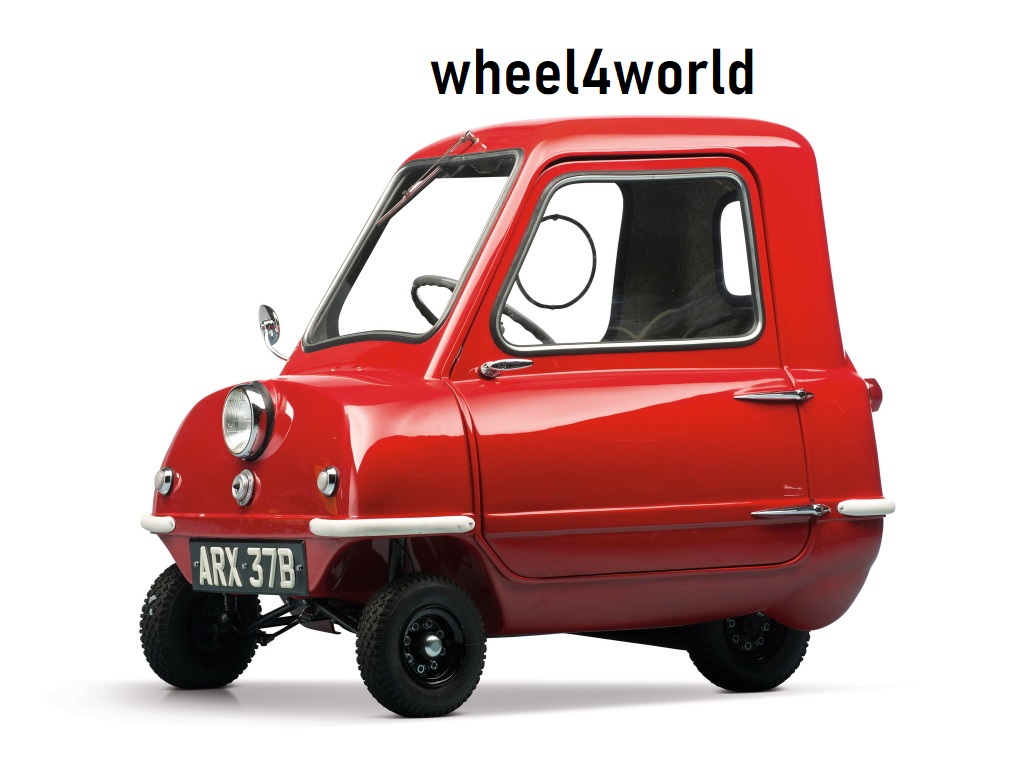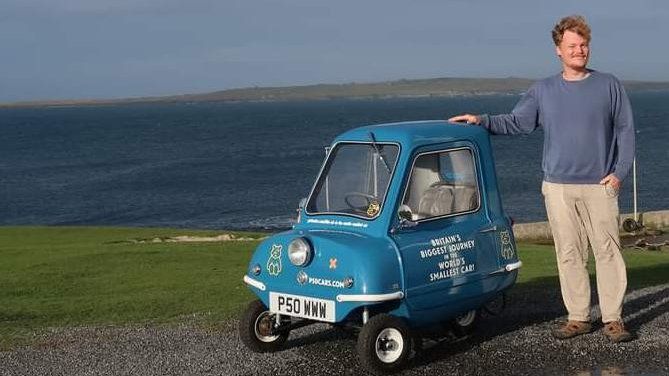
Design And Key Features Of The Peel P50
Introduction to the Peel P50
The Peel P50 is a fascinating microcar that has secured its place in automotive history as the world’s smallest production vehicle. Created by the Peel Engineering Company, it debuted in 1962 on the Isle of Man. The car was designed for one person with limited space for luggage, featuring three wheels, a single door, and no reverse gear. Its ultra-compact design and distinct appearance have made it a cultural icon, representing the idea of minimalist, efficient transportation.
Significance in Automotive History
The Peel P50 holds a unique spot in automotive history because of its innovative design focused on size and efficiency. During an era when urban congestion was becoming more problematic, the P50 offered a creative solution for short-distance travel and tight parking spaces. Its influence can be seen in developing city cars that prioritize compactness and fuel efficiency. Today, the Peel P50 remains a prized collector’s item, celebrated for its distinctive design and pioneering role in microcar innovation.

Peel P50 Specifications
| Dimensions | |
| Length | 1370 mm (54 in) |
| Width | 1040 mm (41 in) |
| Height | 1200 mm (47 in) |
| Wheelbase | 1090 mm (43 in) |
| Performance | |
| Unladen | 105 kg (230 lb) |
| Top Speed | 61 km/h (38 mph) |
| Engine | 49 cc, single-cylinder, two-stroke |
| Power | 4.2 hp (3.1 kW) |
| Transmission | 3-speed manual |
| Fuel Economy | 100 mpg (imp) (2.8 L/100 km) |
| Other | |
| Seats | 1 |
| Doors | 1 |
| Steering | Rack and pinion |
| Brakes | Linked all-wheel |
| Suspension | Independent single-wishbone front, trailing arm rear |
History of the Peel P50
Founding of Peel Engineering Company
The Peel Engineering Company was established in the 1950s on the Isle of Man, initially focusing on boat manufacturing and fiberglass products. The company quickly gained recognition for its innovative use of lightweight materials, which later became essential in creating its most famous product—the Peel P50. Motivated by the idea of producing an affordable, compact vehicle that could easily navigate through crowded city streets, Peel Engineering turned its attention to microcar production.
Creation of the Peel P50 in 1962
In 1962, Peel Engineering launched the Peel P50, a revolutionary three-wheeled microcar designed by Cyril Cannell. The car aimed to provide an ultra-compact and efficient means of transport for one person. Featuring a fiberglass body, tiny dimensions, and a unique look, the Peel P50 represented a bold innovation. Measuring only 54 inches in length and 39 inches in width, it became the world’s smallest production car—a record it still holds today. Its lightweight design made it easy to move, although it famously lacked a reverse gear.
Initial Production and Purpose
The initial production run of the Peel P50 was limited, with around 50 units produced between 1962 and 1965. Designed primarily for city commuters, it offered a practical solution for individuals navigating congested urban environments or seeking convenient parking in crowded areas. With a simple engine capable of reaching up to 37 mph, the P50 was ideal for short-distance travel, like grocery runs or commuting to work. Its minimalist design—featuring one seat, one door, and three wheels—made it affordable and easy to use.
Despite its unique charm, the Peel P50’s production ended after a few years due to limited demand. However, its significance in automotive history has endured, with modern revivals and appearances in pop culture, including recognition in the Guinness World Records as the smallest production car.
Design and Specifications of the Peel P50
Dimensions and Weight
The Peel P50 is celebrated for its exceptionally small size, making it the smallest production car ever made. The car measures just 54 inches in length and 39 inches in width, with a weight of approximately 130 pounds (59 kg). Its ultra-compact dimensions allow it to fit into the tightest parking spots, making it perfect for maneuvering through congested city streets. The lightweight fiberglass body further enhances its easy handling, despite having only three wheels.
Engine and Power
The original Peel P50 was powered by a 49cc DKW engine, a simple yet efficient two-stroke motor. This engine produced around 4.2 horsepower, which, although modest, was adequate for short city drives. The P50 came with a manual transmission featuring three forward gears but no reverse gear. Drivers had to manually push or lift the car to move backward, a task made easier by its light weight.
Unique Single-Seat Design and Compact Size
One of the most distinctive features of the Peel P50 is its single-seat design. The car was built to accommodate just one passenger, with a small space behind the seat for personal items like groceries. It had only one door on the left side and a large window that wrapped around the front and sides, maximizing visibility and maintaining a compact footprint ideal for urban commuting.
Performance and Speed
The Peel P50 was not designed for speed, reaching a maximum of 37 mph (60 km/h), which was sufficient for its intended urban use. Its small engine and lightweight construction provided reasonable performance for short trips and low-speed environments. However, its compact size and three-wheel design made it more suitable for smooth roads than highways or rugged terrain. Its fuel efficiency was another highlight, achieving around 100 miles per gallon, making it both economical and environmentally friendly for its time.
Cultural Impact of the Peel P50
Symbol of Microcars
The Peel P50 has become an enduring symbol of the microcar phenomenon. Its small size and quirky design captivated the imagination of car enthusiasts and casual observers alike. As cities worldwide continue to deal with issues like congestion and pollution, the P50’s concept of ultra-compact, efficient transportation remains relevant. The car’s unique character—blending functionality with charm—has made it an icon in the microcar world, frequently referenced in discussions about urban mobility solutions.
Appearances in Popular Culture and Media
The Peel P50 gained widespread recognition after being featured on the popular British television show “Top Gear,” where host Jeremy Clarkson humorously drove it through the BBC offices. This appearance helped cement the car’s place in popular culture and introduced it to a new generation of viewers. Since then, the P50 has appeared in various media, from documentaries to car shows, becoming a symbol of eccentricity and innovation in the automotive world.
Record as the Smallest Production Car
The Peel P50 holds the Guinness World Record as the smallest production car ever made, a title it still holds today. Measuring just 54 inches long and 39 inches wide, the P50’s diminutive size sets it apart in automotive history. This record has helped the P50 become a cult favorite among collectors and microcar enthusiasts, adding to its allure. Despite its limited production and niche market, its status as the world’s smallest car continues to draw attention and admiration for its innovative design and role in car culture.
Modern Reintroduction of the Peel P50
Re-release of the Peel P50 in the 2010s
The Peel P50 experienced a revival in the 2010s when Peel Engineering decided to reintroduce the iconic microcar due to growing interest from collectors and automotive enthusiasts. This re-release allowed a new generation to experience the charm of the world’s smallest car. The modern version retained the original’s retro appeal while incorporating updated technology to meet current safety and environmental standards. The new Peel P50 was handcrafted like the original, maintaining its status as a unique and exclusive vehicle.
Differences Between the Original and Modern Versions
While the new Peel P50 retained much of the original design and iconic dimensions, there were some key differences. The most notable update was the option for an electric version, providing an eco-friendly alternative to the original gas-powered model. The modern P50 featured an electric motor capable of similar speeds but with quieter and more efficient performance. Other improvements included upgraded materials for better durability and comfort, while the overall look remained true to the original. Unlike the 1960s version, the new model included some basic safety features to comply with modern road regulations, though it remained a niche, low-speed vehicle primarily for novelty use.
Advantages of the Peel P50
Fuel Efficiency and Eco-Friendliness
One of the standout advantages of the Peel P50 is its remarkable fuel efficiency. The original gas-powered version consumed minimal fuel due to its small engine size, making it economical for short trips and urban driving. With the reintroduction of the electric model, the P50 became even more eco-friendly, offering a green alternative with zero emissions. This makes the car an excellent choice for environmentally conscious drivers looking to reduce their carbon footprint while enjoying a piece of automotive history.
Compactness for Urban Commuting
The compact size of the Peel P50, measuring just 54 inches long and 39 inches wide, is ideal for navigating crowded city environments. Its ability to fit into tight parking spaces and easily maneuver through congested streets makes it a practical option for urban commuters. The P50’s ultra-compact design allows drivers to avoid many parking and space issues faced by larger vehicles, making it perfect for city dwellers who need efficiency without sacrificing convenience.
Uniqueness and Collector Appeal
Owning a Peel P50 offers a sense of uniqueness that few other cars can provide. As the smallest production car ever made, it holds a special place in automotive history, making it highly appealing to collectors and microcar enthusiasts. The limited production and novelty factor make the Peel P50 a sought-after collectible, valued for its quirkiness and rarity. Its distinctive design and historical significance make it a conversation starter, enhancing its appeal to those who appreciate owning a unique piece of automotive culture.
Challenges of Owning a Peel P50
Limited Speed and Practicality for Modern Roads
One significant challenge of owning a Peel P50 is its limited speed and practicality on modern roads. With a top speed of just 35 mph (56 km/h), the P50 is best suited for short city commutes or novelty rides, not for highways or long-distance travel. Its small size and low speed can make it difficult to keep up with regular traffic, which may pose problems in fast-paced urban areas or regions without designated low-speed zones. The car’s single-seat design and minimal storage space further limit its practicality for everyday use.
Lack of Safety Features
The original Peel P50 was designed with minimal safety considerations, a common trait among microcars of its era. The absence of modern safety features, such as airbags or crumple zones, makes it a risky choice for driving in today’s traffic conditions. Although the modern re-release includes some basic safety upgrades, the P50 remains a lightweight vehicle with limited protection in case of a collision. Potential buyers should consider these safety limitations when deciding whether to use the car on public roads.
Cost and Maintenance Considerations
The Peel P50, especially the modern re-release, can be quite expensive due to its rarity and collector appeal. Prices for the reintroduced versions can range significantly, depending on the condition and customization options. Maintenance can also be challenging, given the limited availability of parts and specialized knowledge required to service such a unique vehicle. Owning a Peel P50 may require a higher initial investment and ongoing commitment to maintenance and care, which could deter some potential buyers.
Conclusion
The Peel P50 remains an iconic microcar with a unique place in automotive history. As the world’s smallest production vehicle, it represents an innovative approach to urban transportation, offering a practical and charming solution to the challenges of city driving. While it has its limitations in terms of speed, safety, and practicality, the P50’s fuel efficiency, compactness, and distinctiveness make it a beloved collector’s item and symbol of automotive ingenuity. Whether as a piece of history or a quirky means of transportation, the Peel P50 continues to capture the imagination of car enthusiasts and urban drivers alike.
READ MORE : Bad blower motor symptoms


